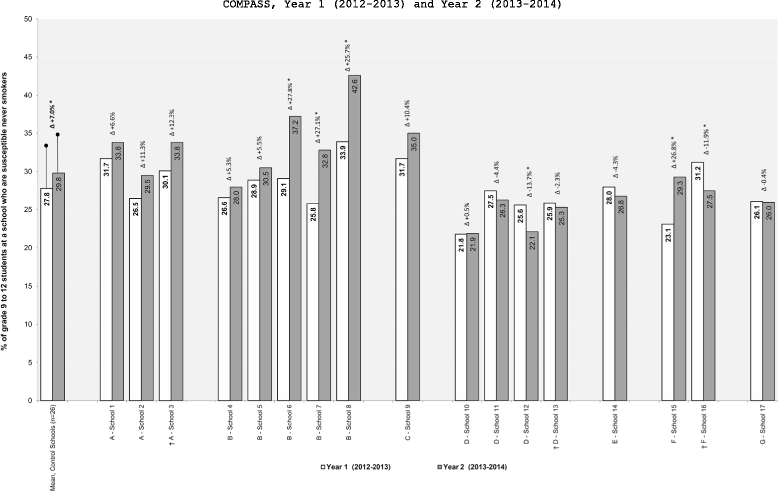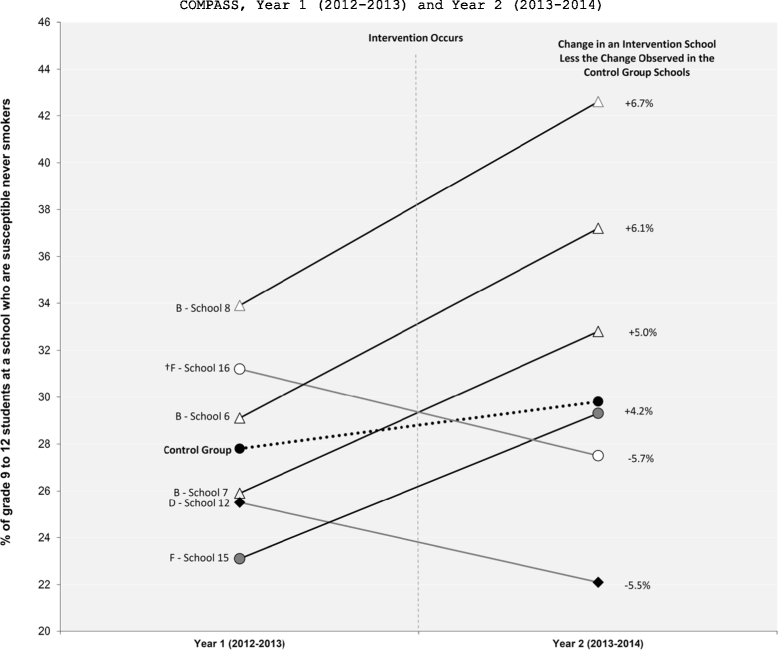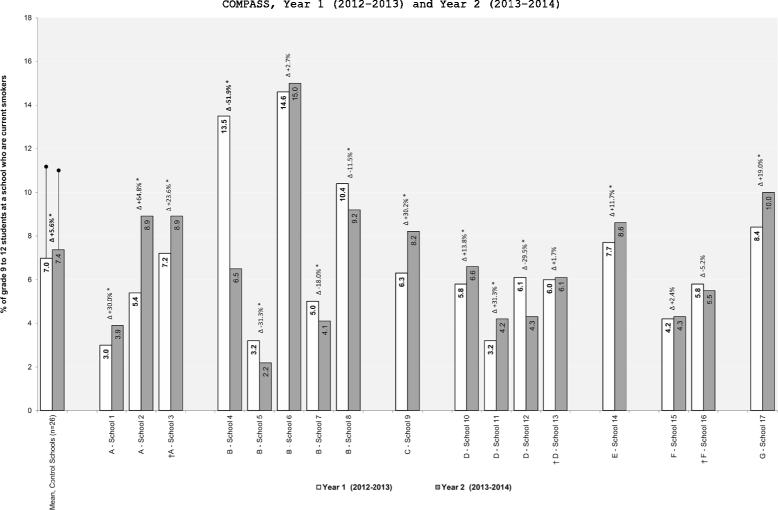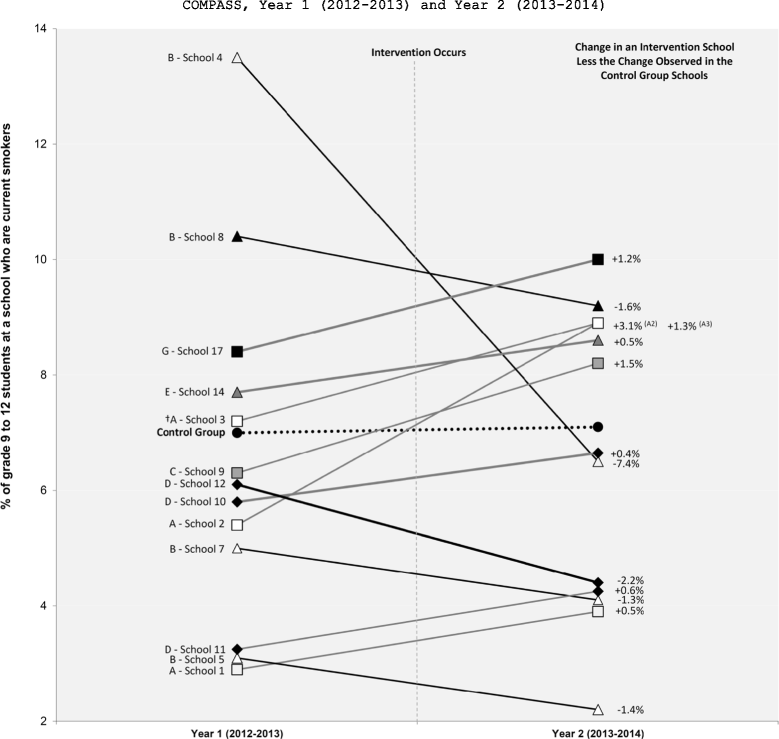Examining the impact of changes in school tobacco control policies and programs on current smoking and susceptibility to future smoking among youth in the first two years of the COMPASS study: looking back to move forward
- PMID: 25834482
- PMCID: PMC4381407
- DOI: 10.1186/s12971-015-0031-1
Examining the impact of changes in school tobacco control policies and programs on current smoking and susceptibility to future smoking among youth in the first two years of the COMPASS study: looking back to move forward
Abstract
Background: School-based prevention activities continue to be an important tobacco control resource, however there is little guidance for school-based tobacco control programming within Ontario. The objective of this study is to identify real-world changes in school-based tobacco control programs or policies in the COMPASS study and examine of those interventions (natural experiments) had any impact on the school-level prevalence of smoking susceptibility and current smoking over time.
Methods: This paper uses longitudinal school-level smoking behaviour data from Year 1 (Y1: 2012-13) and Year 2 (Y2: 2013-14) of the COMPASS study. Changes to school-level tobacco control programs and policies were measured using the COMPASS School Programs and Policies Questionnaire and knowledge broker follow-up interviews. Quasi-experimental tests of proportion and difference-in-difference models were used to evaluate the impact of the interventions identified between Y1 and Y2 on school-level prevalence of smoking susceptibility among never smokers and current smoking.
Results: Between Y1 and Y2, 17 schools reported a change in their tobacco control programming or policies. In four of the intervention schools, the increase in the within-school prevalence of susceptible never smokers between Y1 and Y2 was significantly greater than the natural change observed in the control schools. In five of the intervention schools, the decrease in the within-school prevalence of current smokers between Y1 and Y2 was significantly greater than the natural change observed in the control schools. Only two of the new interventions evaluated (both focused on policies of progressive punishment for students caught smoking on school property), were associated with significant desirable changes in both smoking susceptibility and current smoking between Y1 and Y2.
Discussion: Interventions specific to effective and enforced tobacco control were the most common and consistently had the desired impact on the school-level prevalence of smoking susceptibility and current smoking. Due to the variation in the types of interventions implemented and their effectiveness, additional evaluation evidence is necessary to determine the most successful activities and contexts among individual students. The results presented here highlight which of these real-world promising interventions should be further evaluated using the longitudinal individual-level data in COMPASS over time.
Keywords: Adolescence; Intervention evaluation; Policy; Program; Schools; Smoking; Tobacco; Youth.
Figures




Similar articles
-
School Breakfast-Club Program Changes and Youth Eating Breakfast During the School Week in the COMPASS Study.J Sch Health. 2016 Aug;86(8):568-77. doi: 10.1111/josh.12408. J Sch Health. 2016. PMID: 27374346
-
Changing the Smoking Trajectory: Evaluating the Impact of School-Based Tobacco Interventions on Changes to Susceptibility to Future Smoking.Int J Environ Res Public Health. 2017 Oct 5;14(10):1182. doi: 10.3390/ijerph14101182. Int J Environ Res Public Health. 2017. PMID: 28981472 Free PMC article.
-
A quasi-experimental examination of how school-based physical activity changes impact secondary school student moderate- to vigorous- intensity physical activity over time in the COMPASS study.Int J Behav Nutr Phys Act. 2016 Jul 29;13:86. doi: 10.1186/s12966-016-0411-9. Int J Behav Nutr Phys Act. 2016. PMID: 27473113 Free PMC article.
-
Anti-tobacco policy in schools: upcoming preventive strategy or prevention myth? A review of 31 studies.Tob Control. 2014 Jul;23(4):295-301. doi: 10.1136/tobaccocontrol-2012-050846. Epub 2013 May 28. Tob Control. 2014. PMID: 23716172 Review.
-
Rethinking Responses to Youth Rebellion: Recent Growth and Development of Restorative Practices in Schools.Curr Opin Psychol. 2020 Oct;35:36-40. doi: 10.1016/j.copsyc.2020.02.011. Epub 2020 Mar 2. Curr Opin Psychol. 2020. PMID: 32283520 Review.
Cited by
-
An evaluation of school-based e-cigarette control policies' impact on the use of vaping products.Tob Induc Dis. 2018 Aug 22;16:35. doi: 10.18332/tid/93594. eCollection 2018. Tob Induc Dis. 2018. PMID: 31516434 Free PMC article.
-
Susceptibility to cigarette smoking among secondary and high school students from a socially disadvantaged rural area in Poland.Tob Induc Dis. 2016 Aug 15;14:28. doi: 10.1186/s12971-016-0092-9. eCollection 2016. Tob Induc Dis. 2016. PMID: 27531970 Free PMC article.
-
School-level disadvantage and failed cessation treatment among adolescent smokers.Tob Prev Cessat. 2018 Apr 12;4:11. doi: 10.18332/tpc/87074. eCollection 2018. Tob Prev Cessat. 2018. PMID: 32411839 Free PMC article.
-
School Policy, Administrator Perceptions, and Student E-cigarette Use.Health Behav Policy Rev. 2018 Jul;5(4):72-82. doi: 10.14485/HBPR.5.4.8. Health Behav Policy Rev. 2018. PMID: 30854404 Free PMC article.
-
A supportive school environment may reduce the risk of non-medical prescription opioid use due to impaired mental health among students.Eur Child Adolesc Psychiatry. 2021 Feb;30(2):293-301. doi: 10.1007/s00787-020-01518-3. Epub 2020 Mar 25. Eur Child Adolesc Psychiatry. 2021. PMID: 32215733
References
-
- Leatherdale ST, Rynard V. A cross-sectional examination of modifiable risk factors for chronic disease among a nationally representative sample of youth: are Canadian students graduating high school with a failing grade for health? BMC Public Health. 2013;13:569. doi: 10.1186/1471-2458-13-569. - DOI - PMC - PubMed
-
- U.S. Department of Health and Human Services . Preventing tobacco Use among youth and young adults: a report of the surgeon general. Atlanta, GA: U.S. Department of Health and Human Services, Centers for Disease Control and Prevention, National Center for Chronic Disease Prevention and Health Promotion, Office on Smoking and Health; 2012. - PubMed
LinkOut - more resources
Full Text Sources
Other Literature Sources
Research Materials

